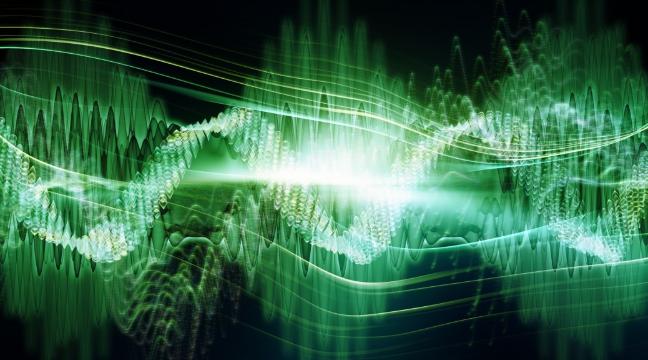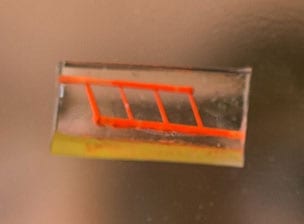
Nothing is more frustrating than watching that circle spinning in the centre of your screen, while you wait for your computer to load a programme or access the data you need.
Now a team from the Universities of Sheffield and Leeds may have found the answer to faster computing: sound. The research – published in Applied Physics Letters – has shown that certain types of sound waves can move data quickly, using minimal power.
The world’s 2.7 zettabytes (2.7 followed by 21 zeros) of data are mostly held on hard disk drives: magnetic disks that work like miniaturised record players, with the data read by sensors that scan over the disk’s surface as it spins. But because this involves moving parts, there are limits on how fast it can operate.
For computers to run faster, we need to create “solid-state” drives that eliminate the need for moving parts – essentially making the data move, not the device on which it’s stored. Flash-based solid-state disk drives have achieved this, and store information electrically rather than magnetically. However, while they operate much faster than normal hard disks, they last much less time before becoming unreliable, are much more expensive and still run much slower than other parts of a modern computer – limiting total speed.
Creating a magnetic solid-state drive could overcome all of these problems. One solution being developed is ‘racetrack memory’, which uses tiny magnetic wires, each one hundreds of times thinner than a human hair, down which magnetic “bits” of data run like racing cars around a track. Existing research into racetrack memory has focused on using magnetic fields or electric currents to move the data bits down the wires. However, both these options create heat and reduce power efficiency, which will limit battery life, increase energy bills and CO2 emissions.
Dr Tom Hayward from the University of Sheffield and Professor John Cunningham from the University of Leeds have together come up with a completely new solution: passing sound waves across the surface on which the wires are fixed. They also found that the direction of data flow depends on the pitch of the sound generated – in effect they “sang” to the data to move it.
The sound used is in the form of surface acoustic waves – the same as the most destructive wave that can emanate from an earthquake. Although already harnessed for use in electronics and other areas of engineering, this is the first time surface acoustic waves have been applied to a data storage system.
Read more: The solution to faster computing? Sing to your data
The Latest on: Faster computing
[google_news title=”” keyword=”faster computing” num_posts=”10″ blurb_length=”0″ show_thumb=”left”]
via Google News
The Latest on: Faster computing
- Super Micro Computer Stock Just Dropped. Is It a Buying Opportunity?on May 1, 2024 at 1:01 pm
That's because Super Micro is in the business of providing server and storage system components to data centers building artificial intelligence (AI) capacity. And its bottom-line earnings expanded ...
- Researchers unlock potential of 2D magnetic devices for future computingon May 1, 2024 at 12:06 pm
"Our research could lead to the development of novel computing devices that are faster, smaller and more energy-efficient and powerful than ever before. Our research marks a significant advancement in ...
- Climate models can run for months on supercomputers – but my new algorithm can make them ten times fasteron May 1, 2024 at 11:36 am
A climate model exploits this by subdividing the surface of the planet into smaller regions – subdomains – with calculations for each region being performed simultaneously on a different CPU. In ...
- Act fast! This RTX 4060 gaming laptop just got $516 off in epic dealon May 1, 2024 at 4:12 am
Right now, the Legion Pro 5i with Nvidia RTX 4060 GPU is on sale at Lenovo. The official store has slashed the regular retail price of $,1,829 down to just $1,313, making for a drool-worthy $515 ...
- 'Super-fast start-up and lots of storage': This bestselling laptop is a steal at $210 — that's over 50% offon April 30, 2024 at 7:23 am
It may be from a little-known brand, but this compact computer holds its own against the big names, shoppers say.
- Logitech targets faster growth via education, health and AIon April 30, 2024 at 6:09 am
Logitech International is targeting faster growth in future by expanding its customer base into areas like education and healthcare as well as doing more with artificial intelligence, Chief Executive ...
- Best system utilities and repair software for business PCs of 2024on April 29, 2024 at 12:32 am
The same applies to your business laptop, too. It’s no surprise therefore that after a few months, your once fast computer can start to feel more sluggish. Help is at hand, however, as there are ...
- Why animals run faster than their robot doppelgängers… for nowon April 24, 2024 at 11:00 am
“It [advances in robots] will move faster, because evolution is undirected,” University of Washington Department of Electrical & Computer Engineering Associate Professor Sam Burden said. “There are ...
- Breakthrough in Quantum Cloud Computing Ensures its Security and Privacyon April 22, 2024 at 6:33 am
Businesses are one step closer to quantum computing thanks to a breakthrough made in its security by scientists at Oxford University.
- Springing simulations forward with quantum computingon April 22, 2024 at 6:06 am
Though "coupled oscillations" may not sound familiar, they are everywhere in nature. The term "coupled harmonic oscillators" describes interacting systems of masses and springs, but their utility in ...
via Bing News









